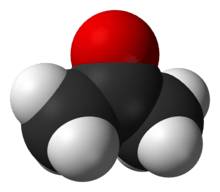Deuterated acetone
From Wikipedia, the free encyclopedia
| Deuterated acetone | |
|---|---|
 |
 |
 | |
| Identifiers | |
| CAS number | 666-52-4 |
| PubChem | 522220 |
| ChemSpider | 455535 |
| EC number | 211-563-9 |
| UN number | 1090 |
| Beilstein Reference | 1702935 |
| Jmol-3D images | {{#if:[2H]C([2H])([2H])C(=O)C([2H])([2H])[2H]|Image 1 |
| |
| |
| Properties | |
| Molecular formula | C32H6O |
| Molar mass | 64.1161 g mol-1 |
| Density | 0.872 g cm-3 |
| Melting point | −94 °C; −137 °F; 179 K |
| Boiling point | 56 °C; 133 °F; 329 K |
| Vapor pressure | 24.5-25.3 kPa (at 20 °C) |
| Hazards | |
| EU classification | |
| R-phrases | R11, R36, R66, R67 |
| S-phrases | S9, S16, S26 |
| NFPA 704 |
 3
1
0
|
| Flash point | −19 °C; −2 °F; 254 K |
| Related compounds | |
| Related compounds | Acetone |
| Except where noted otherwise, data are given for materials in their standard state (at 25 °C (77 °F), 100 kPa) | |
| Infobox references | |
Deuterated acetone ((CD3)2CO) is a form (called an isotopologue) of acetone (CH3)2CO in which the hydrogen atom ("H") is replaced with deuterium (heavy hydrogen) isotope ("D"). Deuterated acetone is a common solvent used in NMR spectroscopy.
| ||||||||
This article is issued from Wikipedia. The text is available under the Creative Commons Attribution/Share Alike; additional terms may apply for the media files.